Women in the Field: A Short Round-Up
If you couldn’t make the symposium on women in the media last week, here’s the lowdown on what you missed.
“‘Equal’ in the Newsroom: More Like Sweet and Low”

Moderated by Ann Rauhala, director of the newspaper stream at the Ryerson School of Journalism, she spent 16 years at The Globe and Mail where she worked as a copy editor, assignment editor, beat reporter, foreign editor and featured columnist.
With panelists:
Karen Levine, prize-winning producer with CBC Radio, who for many years worked on CBC programs including As It Happens, The Sunday Edition and originally produced Hana’s Suitcase as a radio documentary before making it into a book.
Sadia Zaman has spent her entire career in television, both on the screen and behind the scenes. She’s currently director of in-house production at VisionTV and has worked at CBC radio and television in Nova Scotia and Saskatchewan, as well as TVOntario.
Judith Timson is an award-winning freelance journalist and author whose writing about politics, business, social issues and popular culture has appeared in many of Canada’s leading magazines and newspapers. After writing columns in The Globe’s Report on Business, Careers and Focus sections, she began a weekly column in the Life section in late 2007.
Kathy English the Toronto Star‘s public editor. She has reported and edited for the Hamilton Spectator,London Free Press, Toronto Sun, and The Globe and Mail. Kathy taught newspaper journalism at the Ryerson School of Journalism for 10 years and served five years on the board of the National Newspaper Awards.
AR – The average female news director is white, middle aged, middle income and has a less likely chance of having children them other women their age [funnily enough all the panelists and the moderator all have at least one child]. There have been papers written about how women report differently than men, namely that women include more nut graphs, are more descriptive and use more local sources; in other words they are good journalists.
SZ – It’s discouraging to be a woman of colour in this industry. Through a concentrated effort, the CBC has made itself one of the only places where women are in a lot of management roles. “Absolutely yes,” she has experienced discrimination because she’s a woman, specifically when she was being interviewed for a job as an educational journalist, she found out years later that she didn’t get the job because she had a funny name and they didn’t think she would fit into their viewer demographic. In the last few years she has decided to shoot for executive positions where the decisions get made, and she got them.
KL – During a five-hour ride home from Ottawa where she had nothing to do other than listen to the radio Karen was enraged to hear nothing but male presenters and male guests. It’s not enough to just promote women into management roles, it will make no difference if the stories don’t reflect the opinions of women. Noticing is half the battle; male sources and voices send the message that women’s voices aren’t important. Change only happens when it’s demanded, it’s only demanded when it’s made a priority and it’s only a priority when zealots are in charge. She’s nervous about the road ahead and that in a post-feminist 21st century young journalists won’t keep up the fight.
JT – When she first started as a journalist in the 70s, sexual innuendo plagued her and her other young female colleagues. Although this overt sexism would never be tolerated today, she still gets unbelievable sexist and ageist comments on some of her articles. “Don’t assume it’s over, it’s not over and you need to speak up.”
KE – Showed regret that she allowed a male editor to remove the fact that she is an mother of two from her writer bio. Journalists tend to try to hid the fact that they are mothers because of the idea that a woman can’t be both a mother (who can pick her children up at daycare every night) and a journalist (who in theory should be able to drop everything for a breaking story). When she started in her 20s she realized that men were getting the hard news stories where women were getting all the fluff, her worst was a doggie fashion show. But she is happy to see her graduated students take on management roles in newsrooms.
Their last pieces of advice to young journalists about addressing inequalities in journalism…
KE – Find mentors, it’s important to have people to look up to, talk to each other and share issues.
JT – Trust your instincts and find your voice, it doesn’t matter how stupid a story seems, propose it.
SZ – Leave Toronto and turn your back on every obvious story you have ever seen. Think about what’s missing and go get that story.


![[Redacted]](../wp-content/uploads/2014/12/Screen-Shot-2014-12-03-at-11.13.02-AM-150x150.png)












